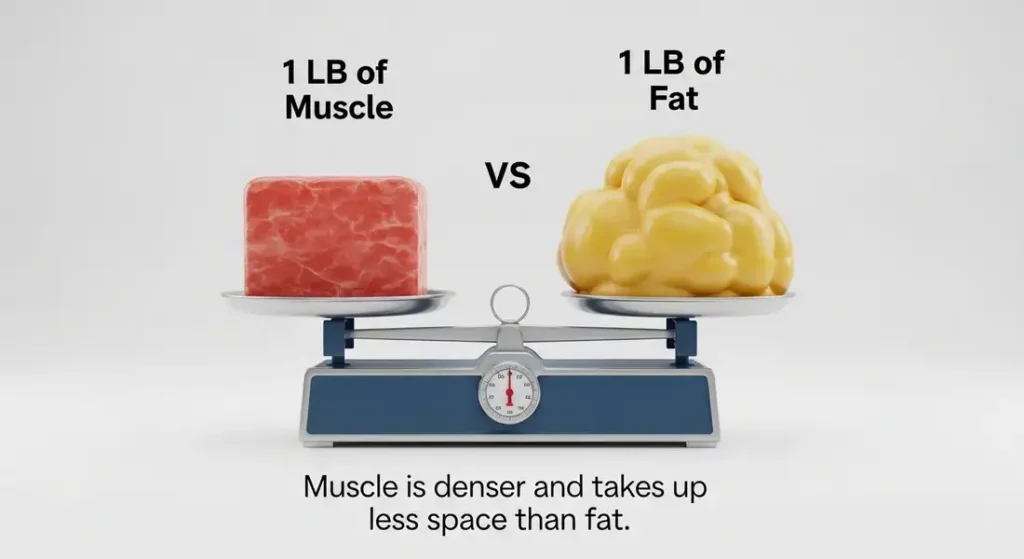You’ve been following your plan. You’re eating better and working out consistently. Then, you step on the scale, and the number hasn’t budged.
The feeling of deflation can be enough to make you want to quit.

If this sounds familiar, I want you to hear this loud and clear: The scale is only one data point, and it’s not the most important one.
As your coach, my goal is to help you see the full picture of your incredible progress.
This guide, part of our Beginner’s Guide to Weight Loss at Home, will teach you how to measure what truly matters—the victories that prove you are getting stronger, healthier, and fitter, regardless of what that number says.
Why the Scale is a Deceptive Tool
Fixating on your daily weight is one of the fastest ways to kill your motivation.
The number on the scale fluctuates daily based on factors that have little to do with your actual fat loss, such as water retention from a salty meal, hydration levels, and hormonal cycles.
Most importantly, as you build lean muscle (which takes up less space than fat), your weight may stay the same even as you lose inches and get healthier.

- Water Retention: A salty meal, your hydration levels, or even your monthly cycle can cause your weight to swing by several pounds in a single day.
- Muscle is Denser Than Fat: As you start strength training, you will build lean muscle. A pound of muscle takes up significantly less space than a pound of fat. This means you can be losing inches and getting leaner while your weight stays the same or even increases slightly.
- It Doesn’t Measure Health: The scale can’t tell you that you’ve lowered your blood pressure, improved your heart health, or gained the strength to lift your groceries with ease.
8 Better Ways to Track Your Progress

Let’s shift our focus to “Non-Scale Victories” (NSVs).
These are the real-world indicators that your hard work is paying off.
1. Take Your Measurements
This is the single best way to track fat loss. A simple tape measure doesn’t lie. Measure key areas once every 4 weeks and record the numbers.
- How to do it: Measure your waist (at the belly button), hips (at the widest point), chest, and thighs. Be consistent with where you place the tape.
- Why it works: Losing inches is a direct indicator that you are losing body fat, even if your weight is stable.
2. The “Clothes Test”
How your clothes fit is one of the most satisfying measures of progress.
That pair of jeans that used to be too tight, the shirt that fits more comfortably around your arms—these are undeniable signs of a changing body composition.
3. Progress Photos
We see ourselves in the mirror every day, which makes it hard to notice gradual changes. Progress photos are your secret weapon.
- How to do it: Once a month, take photos from the front, side, and back. Wear the same clothes, stand in the same spot, and use the same lighting.
- Why it works: When you compare your photos side-by-side after a few months, the changes will be far more dramatic than you realized.
4. Track Your Strength Gains
This is where you can truly see yourself getting stronger. Keep a simple log in a notebook or on your phone.
- What to track: Did you use a heavier dumbbell? Did you complete more push-ups than last week? Were you able to hold your plank for 10 seconds longer? Every single rep or second is a victory.
5. Monitor Your Energy Levels
Remember how you felt before you started?
One of the first things people notice is a massive boost in their daily energy.
You’re no longer hitting that 3 PM slump, and you have more energy to play with your kids or enjoy your hobbies.
This is a huge quality-of-life improvement.
6. Check Your Endurance
Think back to your first cardio session.
Were you out of breath after 10 minutes?
Now, you can go for 30 minutes without feeling completely wiped out.
That is a tangible improvement in your cardiovascular health and fitness.
7. Assess Your Sleep Quality
Regular exercise and a better diet often lead to deeper, more restorative sleep.
Waking up feeling genuinely rested is a powerful sign that your body is becoming healthier and more efficient.
8. Notice Your Mood
Exercise is a proven mood booster.
If you find that you’re feeling happier, more confident, and less stressed, that is a direct result of your hard work.
This mental and emotional progress is just as important as the physical.
Troubleshooting Your Mindset – Overcoming Tracking Frustration
Tracking your journey is a mental game.
Here’s how to stay positive and objective when your emotions run high.
Problem: “I know I shouldn’t, but I’m still obsessed with the scale and it ruins my day.”
You’re not alone. The scale can feel addictive. The solution is to create a set of rules to reclaim your power.
- The Once-a-Week Rule: Weigh yourself a maximum of one time per week. That’s it.
- The Consistency Rule: Do it on the same day (e.g., Friday morning), at the same time, after using the restroom, and before eating or drinking anything. This gives you the most consistent data point possible and eliminates wild daily fluctuations.
- The Data, Not Drama Rule: View the number as a piece of data, not a judgment of your worth. Log it in your journal and immediately move on to tracking your real progress metrics, like your measurements or your workout performance from the week.
Problem: “I’m taking pictures and measurements, but I’m just not seeing any changes.”
It’s very difficult to be objective about our own bodies, and we are often our own worst critics.
- Trust the Long Game: You will not see dramatic changes from Week 1 to Week 2. The magic happens when you compare Month 1 to Month 3. Store your photos and measurements and resist the urge to analyze them too frequently. Trust the process.
- Focus on Performance: If you feel discouraged, turn to your workout log. Are you lifting a bit heavier? Holding a plank longer? Walking faster? These are objective, undeniable proofs of progress. Your body is changing and getting stronger, even if your eyes can’t see it yet.
Coach’s Toolkit – Tools for Tracking What Matters
Having the right tools makes tracking easier, more accurate, and more motivating.
- A Soft Body Tape Measure: This is the most important tracking tool you can own, and it’s not the metal one from your toolbox. A flexible, soft tape measure contours to your body, giving you accurate and consistent readings for your waist, hips, and thighs. This is the ultimate tool for measuring true fat loss.
- A Smart Scale: This might sound contradictory, but a modern smart scale can be a powerful ally if used correctly. It does more than just measure weight; it uses bioelectrical impedance to estimate metrics like body fat percentage and muscle mass. Watching your body fat percentage trend down while your muscle mass trends up is incredibly motivating and gives you the real story that a traditional scale misses.
- A Dedicated Progress Journal: Don’t let your victories get lost in random notes. A dedicated journal allows you to keep your weekly weight, your monthly measurements, your progress photos, and your performance wins all in one place. Flipping back through it after a couple of months will provide a powerful dose of motivation.
Return to the Beginner’s Guide to Weight Loss at Home to review the core principles of your journey.
What non-scale victory are you most excited to track? Share it in the comments below!
